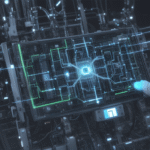Introduction to Decentralized Renewable Energy Grids
In an era marked by rapid climate change and increasing energy demands, the concept of a decentralized renewable energy grid has emerged as a transformative solution for sustainable energy. This guide aims to demystify what a decentralized renewable energy grid is, how it operates, its benefits, challenges, real-world applications, and economic implications.
Understanding Decentralized Renewable Energy Grids
A decentralized renewable energy grid refers to an alternative power supply system that does not rely on a centralized grid or national network. Instead, it integrates multiple distributed energy sources to provide electricity. These sources can include solar panels, wind turbines, microgrids, and biomass power systems.
The primary advantage of such a grid is its resilience. By spreading energy production across various localized sources, it minimizes the dependency on a single point of failure—be it a transformer in a centralized grid or a specific wind turbine in a wind farm. This redundancy enhances reliability and reduces vulnerability to climate-related disruptions.
How Decentralized Renewable Energy Grids Work
Decentralized renewable energy grids operate by harnessing and distributing renewable energy resources at the local level. Unlike traditional grids that rely on large synchronous generators, decentralized grids utilize smaller-scale renewable technologies designed for local use. These include:
- Solar Energy Systems: Photovoltaic (PV) panels convert sunlight into electricity.
- Wind Turbines: Generating power from local wind sources using smaller turbines.
- Microgrids: Self-sustaining power systems that can run independently, often integrating renewable technologies with diesel generators or hydrogen fuel cells for backup.
- Biomass Power Systems: Converting organic waste or biomass into energy through processes like pyrolysis.
These distributed systems work together to create a self-contained energy network within a defined area, serving communities and businesses without access to the national grid.
Benefits of Decentralized Renewable Energy Grids
The transition to decentralized renewable energy grids offers numerous benefits:
- Reduced Carbon Emissions: By replacing fossil fuel-based power generation with renewable sources, these grids significantly lower greenhouse gas emissions, contributing to climate change mitigation efforts.
- Energy Security: Minimizing reliance on centralized grids enhances energy security by reducing the risk posed by grid failures or geopolitical tensions.
- Cost Efficiency: Over time, decentralized systems can become more cost-effective due to economies of scale and improved technology efficiency.
- Environmental Protection: Promoting sustainable practices helps protect natural ecosystems from pollution and resource degradation.
Challenges of Decentralized Renewable Energy Grids
Despite their benefits, decentralized grids face several challenges:
- Infrastructure Costs: Building and maintaining local energy infrastructure can be expensive, particularly in regions with limited resources or political instability.
- Maintenance and Technical Know-How: Managing microgrids requires specialized knowledge and maintenance expertise, which may be lacking in some communities.
- Financial Accessibility: The initial investment required for decentralized systems can be prohibitive for small-scale operators without adequate funding sources.
Real-World Scenarios of Decentralized Renewable Energy Grids
To illustrate the practical applications of decentralized grids, consider the following scenarios:
- Off-Grid Communities: Remote villages in countries like Kenya and Tanzania have successfully implemented off-grid microgrids powered by solar and wind energy to provide essential services without access to the national grid.
- Rural Electrification Projects: In places such as India and Ethiopia, decentralized grids are being integrated into rural electrification initiatives to improve infrastructure and healthcare access for populations previously reliant on kerosene-based lighting or animal dung for cooking.
- Urban Neighborhoods: Cities in developing nations like Bangladesh and Mozambique are exploring microgrid solutions to power essential services while decarbonizing their energy mixes, demonstrating how decentralized systems can complement urban development strategies.
Economic Implications and Growth Potential
The adoption of decentralized renewable energy grids is closely tied to global efforts to combat climate change. As the demand for low-carbon energy sources grows, so does the potential for decentralized grid solutions. Key factors influencing this growth include:
- Technological Advancements: Improvements in renewable technology efficiency and grid management software
- Policy Support: Government incentives such as tax breaks, grants, and renewable portfolio standards
- Public Awareness and Education: Increasing understanding of the benefits of decentralized energy systems among communities
The global renewable energy market is projected to grow from $84 billion in 2019 to nearly $563 billion by 2025. Within this landscape, decentralized grids represent a critical component, particularly for regions with limited access to national infrastructure.
Conclusion: Embracing Local Renewable Energy Solutions
In an era where climate action and sustainable development are paramount, decentralized renewable energy grids offer a promising path forward. By harnessing the collective power of distributed energy sources, these grids empower communities to create self-sufficient energy systems tailored to their needs. Whether supporting off-grid villages or enhancing rural electrification efforts, decentralized grids provide a flexible, resilient alternative to traditional energy systems.
As awareness about climate change and energy security continues to grow, so does the potential for decentralized renewable energy grids to transform how we live and work. By prioritizing sustainable solutions, we can pave the way for a cleaner, more prosperous future where communities are empowered through self-reliant energy systems.







